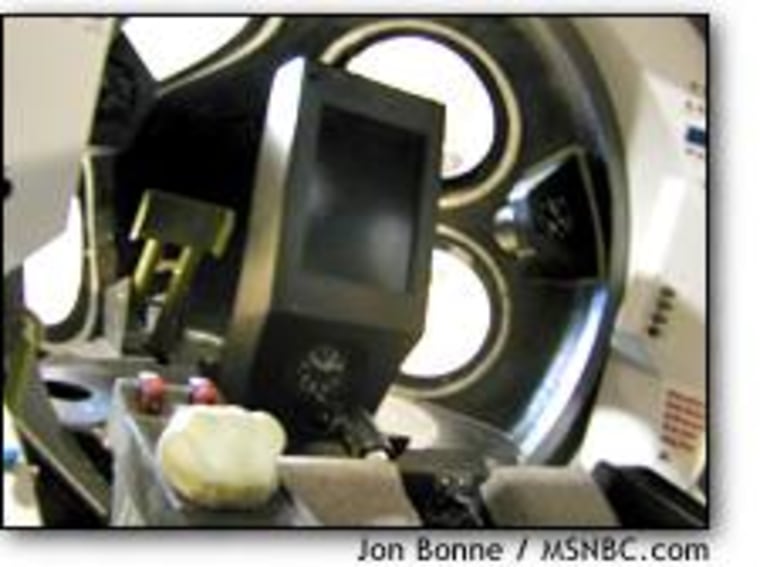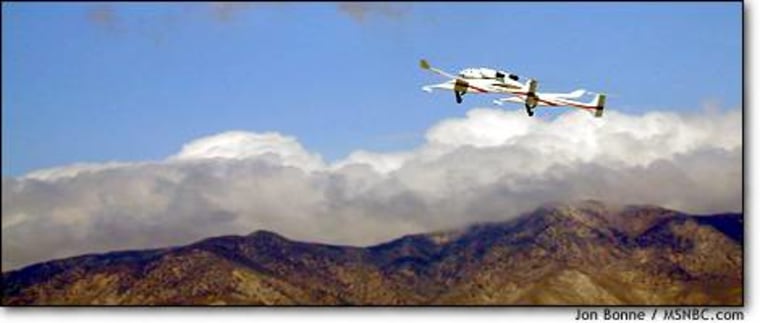Don’t expect to go very far — horizontally, at least — in Burt Rutan’s new space plane. It’s designed to cover just 35 miles over the California desert as it rises above 60 miles in altitude. But its advanced flight systems and stable aerodynamics should make it both thrilling and relatively safe to fly.
Flight begins on the tarmac at Mojave Airport in California, where the White Knight launch jet carries aloft Rutan’s SpaceShipOne suborbital vehicle. The two craft fly east, past Edwards Air Force Base, over the town of Boron, Calif., well inside R-2515, an area of military airspace that has no altitude boundary.
The White Knight is itself an impressive aircraft, with rapid climb and bank capabilities. Its 82-foot wingspan lets it stay aloft at flights near 60,000 feet. Its two J-85-GE-5 engines, the same ones used by the U.S. military’s T-38 training jet, run off up to 6,400 pounds of standard Jet A fuel used in commercial jets, enabling the White Knight to stay aloft for hours and carry up to an 8,000-pound payload. Its cockpit is identical to SpaceShipOne’s, with the exception of the switches that arm and fire the space plane’s rocket.
If anything is a bit tricky, it’s the small windows in both aircraft, which were as large as engineers would allow for the immense pressure differences they would need to handle. The size limits visibility at takeoff and landing, but the biggest problem with them is actually looking out for other air traffic, though ground control and collision-avoidance technology help out.
“While it’s certainly not the best visibility of any airplane, it’s more than adequate,” says Doug Shane, the project’s operations director and one of its four test pilots.
Midair rocket launch
SpaceShipOne’s launch procedure is remarkably similar to the X-15 program, and even to the early supersonic tests conducted over the same airspace over 50 years ago. Once the two aircraft reach 53,000 feet, SpaceShipOne is released from the docking system and the White Knight peels up and away to clear the airspace.
SpaceShipOne glides forward as its pilot pulls the control stick back, letting the ship slow to 140 knots and pulling it into a nose-up pitch between 80 and 90 degrees.
The pilot then reaches to the left and flips the switches to fire the hybrid rocket engine, which runs off a mixture of hydroxyl terminated polybutadiene (HTPB), a rubbery substance used in many rocket engines, and nitrous oxide, also known as laughing gas.
At that point, it’s crucial for the pilot to be at a maximum vertical pitch in order to reach peak altitude, since the ship’s rocket-powered ascent is meant to go almost straight up. It’s especially tricky at that point because the entire project was developed with manual control systems.
“There’s no autopilot. You’re on your own,” says Mike Melvill, one of the other test pilots. Melvill developed the docking system for the two spacecraft and has launched many of Rutan’s projects. “If you get in there and do a half-assed job, you’ll go to only 200,000 feet.”
That would be enough for many folks, but not enough to hit the suborbital goal of 328,000 feet — 100 km, or 62 miles — that would qualify as passing the boundary between the atmosphere and space. That goal is echoed in the paint on SpaceShipOne’s side: Its FAA designator is N328KF.
(Spacecraft designed for orbital flight go much higher: John Glenn, the first American to orbit the Earth, did so at an altitude of 160 miles; the international space station orbits at around 250 miles above the Earth.)
(Relatively) slow speed
The ride, though, is at relatively low speeds — with a maximum true airspeed of just over Mach 3, around 2,400 mph. Because the atmosphere at launch altitudes is so thin, SpaceShipOne’s indicated speed is far lower, topping at about 270 knots.
SpaceShipOne’s controls for use in subsonic flight are very basic, with the stick and rudder pedals manually controlling flight surfaces — familiar technology even in basic training airplanes. Beyond Mach 1, the manual controls become too hard to move and control shifts to electronic systems, just like Chuck Yeager’s X-1 and other early supersonic aircraft. Electronic trim switches also allow the pilot to make precise changes to control configurations. Ingeniously, the same stick also switches over to control SpaceShipOne’s thruster systems, which shoot cold carbon dioxide from exhaust vents at 6,000 psi to fly the ship once outside the atmosphere. The unified control systems make it a cinch for the pilots to control the moves up through the atmosphere and back.
“It actually is a very natural transition,” says Shane. “There really isn’t anything that you have to do fast.”
Perhaps it’s too effortless. Were it not for the avionics panel that shows every bit of flight data in detail, Shane says, “you might not even notice (from the cockpit) when you reach apogee.”
Gliding home
The avionics system is pretty essential for the trip home. It consists of a self-contained inertial navigation system, verified by a constant GPS feed, that tracks every aspect of the ship’s movement and updates every tenth of a second.

It feeds into a custom-designed flight director system that shows the pilot not only the spacecraft’s necessary position for the flight path but also its potential trajectory based on even the smallest shift in position, as well as its precise location over key landmarks on the ground, including airport runways. If the pilot follows the system’s lead, it’s an easy glide back to the ground.
Once the rocket fuel burns itself out, descent hinges on the feathering of SpaceShipOne’s rear surfaces.
The pilot pushes forward two levers on the left side of the cockpit seat, and the twin rear stabilizers flip to vertical. That leaves the ship with enormous drag and a tiny load, enough to allow a quick drop into the atmosphere at an almost leisurely 155 knots.
The slow speed and suborbital altitude keep the outside surfaces of the ship from overheating. Rutan’s engineers predict maximum temperatures of 1,000 degrees Fahrenheit, with small enough exposed areas that only about 20 percent of the ship’s external shell needs thermal protection. Even if the protection fails, Rutan insists, the exposed areas wouldn’t place the crew in jeopardy.
Inside the ship, meanwhile, environmental systems allow the pilot to sit in a cloth flight suit. As Rutan describes it, they “put a spacesuit outside the spaceship”: creating redundant systems for the windows and seals that emulate the thermal protections needed to keep the crew comfortable. The biggest problem — moisture — is handled with desiccants that are built into the ship. White Knight has an identical system, as does Rutan’s earlier Proteus jet.
As SpaceShipOne continues its slow, unpowered glide toward the desert below, the flight director system shows the necessary nose-down attitude to hit a waypoint directly above the Mojave runway at 8,600 feet. From there, one precise 360-degree turn at a safe 30-degree bank angle puts the plane on short final approach, 500 feet above Mojave’s runway, for an easy landing.
The landing procedure can be practiced in the White Knight, as well as in the system’s robust simulator system, designed by test pilot Peter Siebold. The simulator contains the same systems as both the space plane and the launch jet, and controllers can use a desktop computer outside to simulate failures and mishaps in any aspect of the aircraft systems. Between the three sets of identical systems, all four pilots can extensively cross-train.
(I took a quick spin in the simulator and managed a stable descent, though my initial rate of descent left me too low to hit the final descent point. Still, for a first try. ...)
For the pilots, the biggest drawback might be the flight’s duration. Though White Knight is expected to take about an hour to reach launch altitude, SpaceShipOne’s flight out of the atmosphere is done in minutes and the whole descent takes under 20 minutes.
“In an hour and a half,” Melvill says, “you’re going to be back on the ground.”
